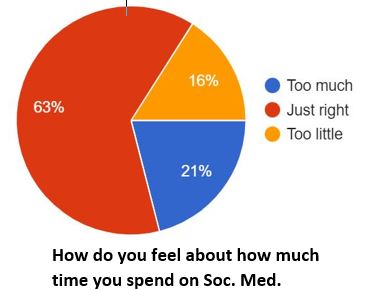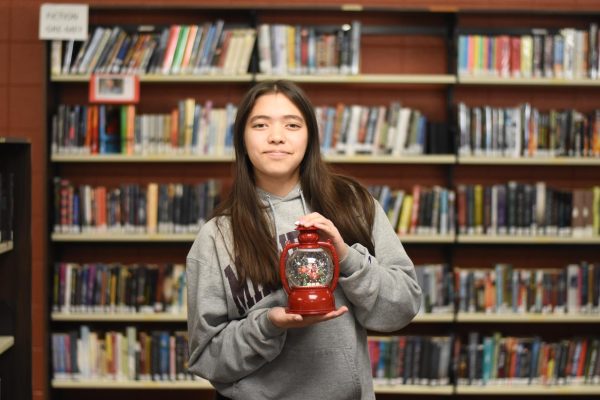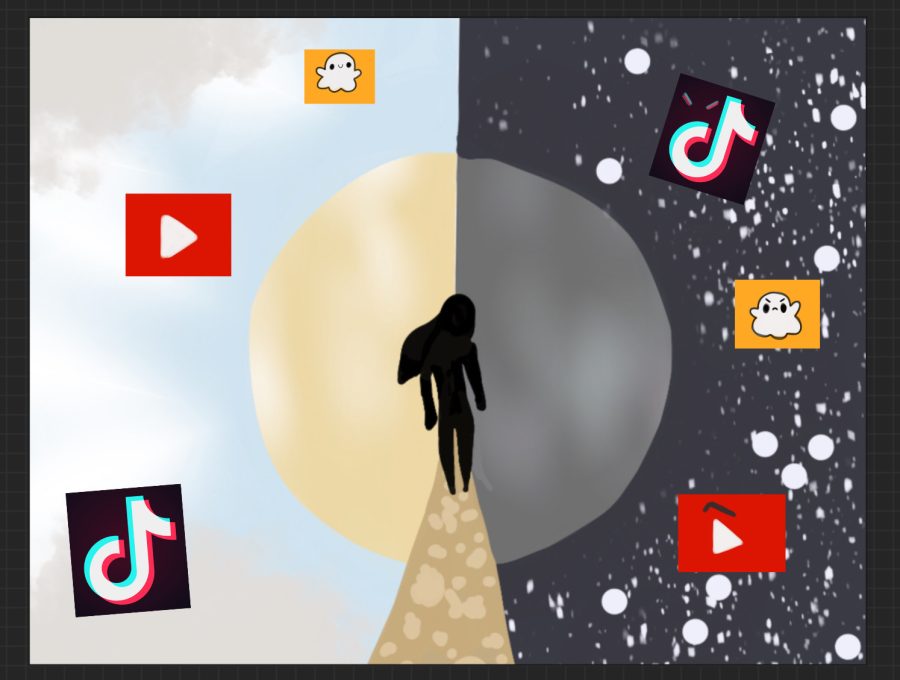Choosing the correct path
Cannon Falls Middle School students were recently surveyed about their social media choices. The results have both positive and negative implications.
Social Media in Middle School can be a difficult path to navigate
Jennie scrolled through her phone and decided to go to her personal profile and look at one of her posts; she saw that someone commented on that post. She read it and saw that they were describing how skinny she was and wasn’t able to fit in her clothes. Jennie started to tear up about the comment and threw her phone in the trash can, never wanting to see it again. Throughout the week she isolated herself in her bedroom, but then decided to go to a psychologist as she knew this wasn’t healthy. Jennie isn’t the only one who has been affected by this type of experience; millions of teens across the globe have dealt with this problem. Social media has all sorts of effects on people, whether they be good or bad. The key is figuring out how to make it a positive environment for adolescents.

The majority of the students at Cannon Falls Middle School took a survey to determine their reactions to social media use. Around 90% of 201 students said they spent less than five hours on Facebook, Twitter, or Twitch in a week, while around 31% of students spend over 10 hours a week on TikTok. When asked how much time they spend on social media, 63% of people claimed that their usage was just right, while 21% said too much, and 16% said too little.
Two students at Cannon Falls MS were interviewed about their views on social media. Emma Templin, a seventh grader, was asked how difficult it would be to quit social media, and said “I think it would be pretty difficult,” and goes on to say that if necessary, she could quit. Kellan Showers, another seventh grader, agreed. He also said that social media has “impacted my life very much because I get to talk to friends a lot more, and I get to meet new people.” Kellan went on to say that he spends about seven hours a day on social media, while Emma only spends two to three, due to sports and other activities.
Although using social media may seem pretty harmless, there are many negative effects it can cause to adults and teens who use it. Several studies have shown that many teens and young adults have experienced psychological issues due to social media. According to the Unicef organization (“Is social media bad for teens’ mental health?”), it is no secret that social media platforms were deliberately designed to hold users’ attention as long as possible. This result was evident in the Cannon Falls social media survey, where 79.5% said it would be somewhere between somewhat difficult and impossible to quit using social media.

According to CNN, “Tik Tok may surface potentially harmful content related to suicide and eating disorders to teenagers within minutes of them creating an account.”. The IFS stated (“Is TikTok Dangerous for Teens?”) “Alyssa Moukheiber, a dietitian at a residential treatment center for eating disorders in northern Illinois, says, ‘The TikTok algorithm is just too strong.’ The algorithm sucks girls into a world that promises physical perfection for just trying a little harder.” However, TikTok isn’t the only platform affecting teens and young adults negatively. Researchers at Tufts University found that although YouTube has positive effects on teens; many other social media platforms can cause a decrease in teens’ mental health, with Snapchat and Instagram being the worst. The CDC conducted a study which showed that 1,769 teenagers had committed suicide in 2015, which increased by about 20% from 1,386 in 2010.

A study conducted by researchers at Glasgow University showed that many kids and pre-teens were staying awake until the morning hours, using social media. Some of these people were using multiple devices to view more than one site at a time. Researchers at Stanford University coined the phrase “Duck syndrome” to explain the attitude of new freshmen that they’re struggling while everyone else is gliding along smoothly. Social media can temporarily relieve feelings of loneliness, however, it can end up causing one to feel even more lonely in the long run. Teens who often communicate through social media are more likely to have less developed social skills. This is because you cannot express things such as body language and facial expressions, along with tone of voice, through social media.
While there are many disadvantages to social media, not all of it is negative. According to The Washington Post (“Five ways social media can be good for teens”), there are also many perks that come in the package. One perk is that when people are on social platforms, they are staying connected. Especially during COVID-19, it was sometimes a struggle to communicate with friends and loved ones. Using social networks made it much easier to chat with others. Even now, people can check up on their friends to see how they are doing whenever they make a post. Therefore, social media helps strengthen friendships, which was also stated by The Washington Post article cited above. In addition to that, the CFMS social media survey said that about 55% of students felt more connected to friends through social platforms.

It can sometimes be difficult for teens and young adults to express themselves; social media networks can help with that. Creating an account on a social platform can allow people to show who they are, and can find things in common with others. The Washington Post article goes on to state that “it can offer a sense of belonging.” Not only that, but teens can provide support for people, as well as receive some. Along with being entertained by social media, teens can also learn things. By seeing how other people live their lives, they are being educated on others’ experiences.
By taking the necessary steps, social media doesn’t have to be a negative thing. Limiting screen time is a sure way to prevent overuse. Instead of spending time chatting with friends online, teens should meet people in person, since interacting with others in real life is beneficial to social skills. Since it can be hard to regulate social media use, some platforms are making an effort to improve their sites. TikTok, a very popular social network among children and adults, is working to make it a safer space for their users. According to CNN Business, TikTok is including ways to “filter out” potentially problematic videos. Not only that, but they are also offering more parental controls, to make their site safer for teens. By making an effort, society can change social media for the better.
Posted in the Torch the Middle school newspaper, located on the bottom of the Lantern.

Hi everyone! I’m a freshman and this is my fourth year writing for the newspaper, which I find to be a lot of fun. I also play volleyball and run track,...

Hey there! My name is Abby and I’m in 7th grade. I enjoy music and writing, and I’m currently involved in band, MS student council, math league, dance,...

